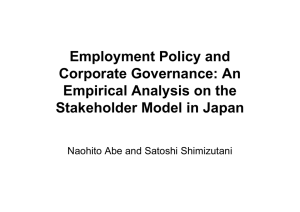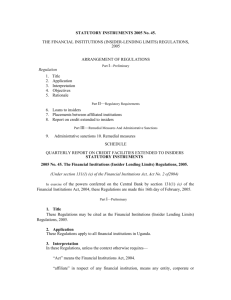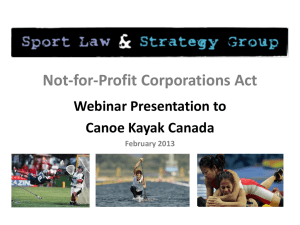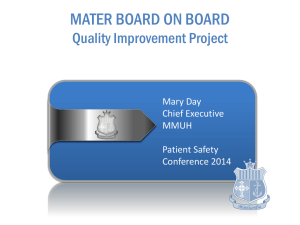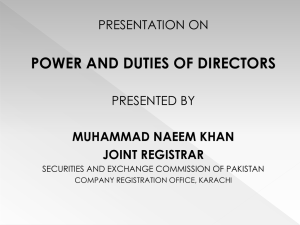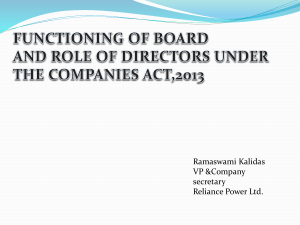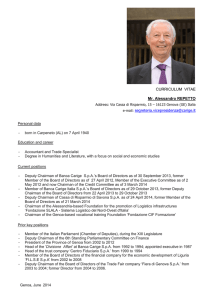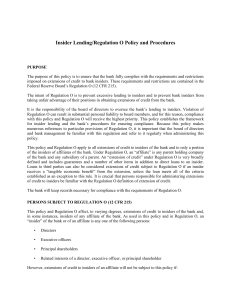Corporate Governance in Jamaica: A Risk
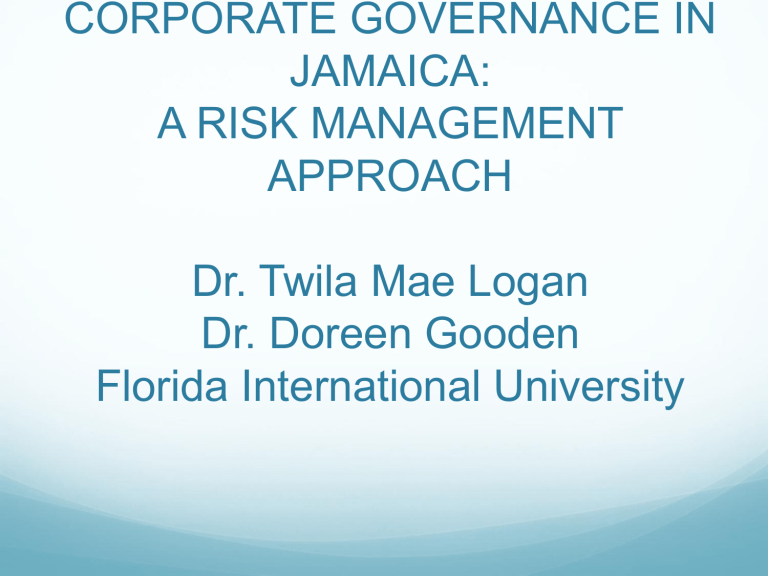
CORPORATE GOVERNANCE IN
JAMAICA:
A RISK MANAGEMENT
APPROACH
Dr. Twila Mae Logan
Dr. Doreen Gooden
Florida International University
Purpose of Study
To examine:
The impact of board composition and ownership structure on the riskiness and value of publicly traded non-financial firms in Jamaica
Background
The late 1990’s financial crisis in Jamaica – increased the awareness for appropriate governance mechanism resulting in
-
- Tightening of banking laws and regulations -
Company Act Legislation
Background
Capital Market poorly developed
Emergence of junior stock market
Trading is relatively thin
Corporate Bond market is virtually non-existent
Jamaica Stock Exchange (JSE) established in 1968
- only 18 non-financial firms trading on the main index
- 13 non-financial firms on the junior market
Background (Cont’d)
Thus – need for research to determine best practices in corporate governance:
- to enhance investors confidence
- further development of capital market.
Few studies done on Jamaica publicly traded firms.
LITERATURE REVIEW – Board
Composition and Risk
DAMODARAN (2008) – Risk taking behavior is related to individual traits and characteristics
- women in senior positions less risk averse than male counterparts
- more experienced persons are more risk averse than naïve persons.
LITERATURE REVIEW – Board
Composition and Risk
Rachdi and Ameur (2011) – 11 Tunisian Banks – smaller boards associated with better performance and more risk taking.
Independent directors (outside, non-executive) had lower performance and no significant effect on risk taking.
LITERATURE REVIEW – Board
Composition and Risk
Kyereboah-Coleman & Biekpe (2007)
– firm risk level decreased with outside directors
- firm risk increased with increasing board size.
Brick and Chidambaran (2008) negative relationship between firm risk and the level of board monitoring
LITERATURE REVIEW – Ownership and Risk
Jensen & Meckling (1976) Jensen & Murphy (1990)
- shareholders by corporate insiders result in greater risk taking.
Gadhoum and Ayadi (2003) positive relationship between firm risk taking and insider holdings.
firm’s risk is negatively related to ownership structure
LITERATURE REVIEW –
Ownership and Risk
Wright et.al. (1996)
Increasing insider’s stake may represent a significant portion of person wealth – hence less incentive for reducing risk.
Growth opportunities can influence risk taking.
LITERATURE REVIEW – Ownership and Value
Shliefer & Visny (1986)
McConnell & Searves (1990) both found
Ownership structure affects the value of firms
Turki & Sedrine (2012) found that
- increased ownership concentration is associated with lower firm performance
- increased managerial ownership is consistent with better firm performance.
Methods
Uni-variate descriptive statistics
Multiple regression with small samples
Robust regression
Reduces the influence of outliers
Data
Publicly traded non-financial firms
17 main exchange
8 junior exchange
Dependent variables : Weekly returns and standard deviation from October 2010 – October 2012
Independent variables: board and ownership composition
Results – Board Composition
Board Size – Average of 8.6 directors (median 8),
On average 17% were female directors (median 17%)
Average of 28% of board members were insiders
(median 29%)
Ownership Composition
Top ten shareholders held on average 79% (median of 87%)
Institutional investors held on average 12% (median 7%)
Insiders held on average almost 30% of the shareholdings.
The average board shareholding was 36% with a median of
20%.
The average managerial shareholding was 19% while the median was 1.5%,
Riskiness/Volatility of Returns
Models R 2 : 26% and 30%
In addition to weekly returns, the riskiness of the firm was increasing in insider percentage, and the largest ten shareholders, but decreasing in board shareholdings.
Not significant
Percentage of female directors
listed on the junior market
Discussion
Insiders are in a better to position to engage in riskier projects. [Jensen & Meckling (1976) and Jensen &
Murphy (1990) Gadhoum and Ayadi (2003)]
Increases in board shareholdings result in lower risk.
This is consistent with directors being risk averse - loss of personal diversification [Wright et. al., 1996].
Returns/Value
Model R 2 : 40% and 42%
Increases in managerial share ownership resulted in larger weekly returns (value).
Positive but insignificant coefficients on
Top ten block share holdings
institutional shareholdings was positive but not significant.
Number of insiders
Discussion
Increases in managerial share ownership result in larger weekly returns. [see Morck et.al., (1988),
Jensen and Meckling, (1976].
The coefficient on institutional shareholdings was positive but not significant [Ming &Gee, (2008)]
Discussion (cont’d)
More insiders did not significantly increase the weekly returns even though more insiders are associated with increased risk.
Implications/Conclusions
Managerial Ownership and Value
Investing strategy
Policy to encourage greater equity stakes.
Implications and Conclusions
Inside Directors and value and risk
Increased riskiness is only beneficial if this results in greater returns
Policy on proportion of inside directors for publicly traded firms.
